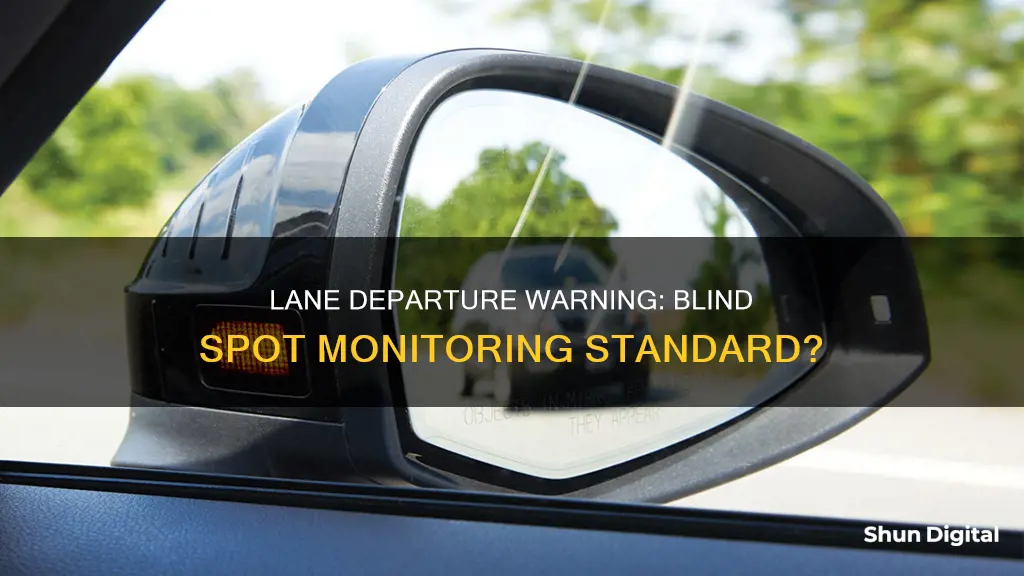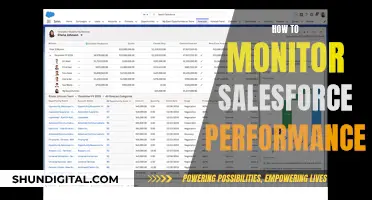
Lane departure warning and blind spot detection are two features of advanced driver assistance systems that are designed to prevent crashes and save lives. Lane departure warning alerts the driver when their vehicle is about to veer out of its lane, while blind spot detection warns the driver of vehicles in their blind spot during lane changes. These two features are often bundled together in vehicles, along with adaptive cruise control. While lane departure warning and blind spot detection can improve safety, they are not substitutes for an engaged driver.
What You'll Learn
- Lane departure warning systems are designed to address fatal crashes
- Blind spot monitoring systems are useful when merging onto a busy highway
- Lane-keeping assistance actively prevents vehicles from leaving their lane
- Lane departure warning systems are not a substitute for engaged drivers
- Lane-keeping systems are particularly useful for driving on freeways and highways

Lane departure warning systems are designed to address fatal crashes
Lane departure warning systems are designed to address often-fatal crashes. In 2015, nearly 13,000 people died in single-vehicle, head-on, and sideswipe crashes where a car unintentionally left its lane. Lane departure warning systems use a camera to scan the road ahead for lane markings and notify the driver with an audible, visual, or tactile warning when the vehicle leaves its lane. This technology is designed to reduce the number of fatal crashes by preventing lane departures, which can lead to deadly collisions.
Lane departure warning systems are passive systems, meaning they do not actively intervene to prevent lane departure. Instead, it is up to the driver to make the necessary steering and braking adjustments to return the car to its lane. While these systems can provide valuable assistance to drivers, they are not a substitute for an engaged driver. Drivers should not rely solely on lane departure warning systems and should stay alert and engaged while driving.
Research has shown that lane departure warning systems are effective in reducing crashes. A study by the Insurance Institute for Highway Safety (IIHS) found that lane departure warning systems lower the rates of single-vehicle, sideswipe, and head-on crashes by 11% and reduce the rates of injury crashes of the same types by 21%. This means that thousands of lives could be saved each year if all vehicles were equipped with lane departure warning systems.
In addition to preventing crashes, lane departure warning systems can also improve driver safety by encouraging the use of turn signals and keeping drivers' hands on the steering wheel. These systems can also help reduce the risk of rollover accidents, which can occur when a driver oversteers while trying to correct a lane departure. Overall, lane departure warning systems are a valuable tool for improving road safety and reducing the number of fatal crashes.
While lane departure warning systems are effective, there are some limitations to their performance. For example, road conditions such as worn pavement markers, construction zones, and intersections can cause the system to lose track of lane location. Additionally, drivers may find the litany of alerts and warnings confusing, especially if they are similar to those of other advanced driver assistance features. It is important for drivers to familiarise themselves with the system and stay engaged while driving to ensure the system is used effectively.
LCD Monitors: Simulated Wave, Real Impact?
You may want to see also

Blind spot monitoring systems are useful when merging onto a busy highway
Blind-spot monitoring systems are a useful safety feature when merging onto a busy highway. They can alert the driver to vehicles in their blind spots, helping to prevent accidents and improve overall road safety. This is especially useful when merging onto a busy highway, as it can be challenging to keep track of surrounding vehicles.
Blind-spot monitoring systems use sensors mounted on side mirrors or the rear bumper to detect vehicles in adjacent lanes. When the sensors detect something, they alert the driver through audible or visual warnings, such as a beep or a flashing light. Some vehicles also use cameras as part of the system or to complement the sensors. This technology has become more affordable and is now offered across various vehicle segments, not just luxury cars.
While these systems are valuable, they have limitations. For example, a recent AAA study found that blind-spot monitoring systems struggled to detect fast-moving vehicles when merging onto busy highways, with alerts often coming too late for evasive action. Additionally, these systems had difficulty detecting motorcycles, providing alerts 26% later than for passenger vehicles.
Despite these limitations, blind-spot monitoring systems can still be highly beneficial when merging onto a busy highway. They can provide drivers with additional information about their surroundings, allowing them to make more informed decisions. However, it is important to remember that these systems do not replace the need for an engaged and attentive driver. Drivers should stay alert and consult their vehicle's owner's manual to understand how these systems work and their limitations.
In conclusion, blind-spot monitoring systems are a valuable tool for drivers when merging onto a busy highway. They offer improved awareness of surrounding vehicles, helping to prevent accidents and enhance overall road safety. However, it is essential to recognise their limitations and for drivers to remain vigilant and actively engaged in the driving process.
Vertical Monitors: Optimal Viewing Sizes for Comfort
You may want to see also

Lane-keeping assistance actively prevents vehicles from leaving their lane
Lane-keeping assistance is a useful feature of driverless technology that actively prevents vehicles from leaving their lane. Lane departure warning systems notify the driver when the vehicle leaves its lane, but lane-keeping assistance goes a step further by allowing the vehicle to steer itself back into the correct lane. This technology is especially useful for drivers who are tired or distracted, as it helps to prevent accidents caused by lane departures, which can be dangerous and even fatal.
Lane-keeping assistance typically uses a camera mounted behind the rearview mirror to detect the road lines and identify whether the vehicle is on the correct path. If the vehicle begins to veer off course, the system will activate and make the necessary adjustments to the steering, brakes, or acceleration to bring the vehicle back into its lane. This can range from gentle pushes to full-on measures, and the driver can override the system at any time and take control of the vehicle.
Lane-keeping assistance is often bundled with other safety features such as blind-spot monitoring and forward-collision warning. Blind-spot monitoring uses radar or sonar sensors to detect vehicles in the driver's blind spot, while forward-collision warning uses sensors to detect slower-moving or stationary vehicles ahead and provides a warning to the driver. These systems work together to improve safety and reduce the risk of accidents.
While lane-keeping assistance is a valuable tool, it is not perfect and may not work well in certain conditions, such as rain or snow, or on roads with faded or missing lane markings. Additionally, the system may not be effective on winding or narrow roads, or when the driver needs to take a wide path to avoid a cyclist or pedestrian. It is important for drivers to stay engaged and not rely solely on lane-keeping assistance or other driver-assistance technologies.
Overall, lane-keeping assistance is a significant advancement in vehicle safety, providing drivers with an extra layer of security and helping to prevent accidents caused by lane departures. It is a useful feature for anyone who drives long distances, at night, or while tired or distracted.
Unlocking LCD Monitors: A Step-by-Step Guide to Success
You may want to see also

Lane departure warning systems are not a substitute for engaged drivers
Lane departure warning systems are designed to minimize accidents by addressing the main causes of collisions: driver error, distractions, and drowsiness. These systems use a combination of cameras, laser sensors, and infrared sensors to detect when a vehicle is leaving its lane and provide warnings through visual, audible, or vibration alerts. While lane departure warning systems are a valuable safety feature, they are not a substitute for an engaged driver. Here are some reasons why lane departure warning systems should not be solely relied on:
- System Limitations: Lane departure warning systems have several limitations that affect their effectiveness. They rely on visible lane markings to function properly, and may struggle with worn pavement markers, construction zones, intersections, or roads without clear lane markings. Additionally, external factors such as snow, leaves, fog, or debris can obstruct the system's ability to detect lane markings.
- Driver Engagement: While lane departure warning systems provide alerts, it is ultimately the driver's responsibility to make the necessary steering and braking adjustments to return the vehicle to its lane. Staying engaged and attentive is crucial, as the system does not actively intervene to prevent lane departure.
- False Sense of Security: Overreliance on lane departure warning systems can lead to a false sense of security. Drivers should not become complacent or less vigilant due to the presence of these systems. It is important to remember that the technology is designed to assist, not replace, the driver's responsibility to maintain control of the vehicle.
- System Variability: Lane departure warning systems can vary significantly across different vehicle makes and models. It is essential for drivers to familiarize themselves with the specific functionality and limitations of the system in their vehicle by consulting the owner's manual and gaining experience with the technology.
- Alert Timing: In some cases, lane departure warning systems may provide alerts too late for evasive action, especially when dealing with fast-moving vehicles or certain road conditions. Drivers should not assume that the system will always provide timely warnings and should remain vigilant and engaged.
- System Interference: Lane departure warning systems can sometimes interfere with other advanced driver assistance features, leading to confusion. It is important for drivers to understand how the system interacts with other technologies in their vehicle to make informed decisions.
In conclusion, while lane departure warning systems offer valuable assistance and can help reduce accidents, they should not be seen as a replacement for engaged and attentive driving. Drivers should prioritize staying alert and maintaining control of their vehicle, utilizing lane departure warning systems as a supplementary safety measure.
Troubleshooting the ASUS VP28UQG Monitor's Black Screen Issue
You may want to see also

Lane-keeping systems are particularly useful for driving on freeways and highways
Lane-keeping systems are incredibly useful for driving on freeways and highways. These systems use cameras to monitor a car's lane position and gently steer the vehicle back towards the centre if it drifts too close to the edge. This is particularly helpful for driving on freeways and highways as these roads tend to have higher speed limits, heavier traffic, and multiple lanes. Lane-keeping systems can help prevent accidents by ensuring that the vehicle stays within its lane, reducing the risk of sideswiping or head-on collisions.
Lane-keeping technology is especially beneficial for long-distance driving, such as on freeways and highways, as driver fatigue is a common issue. The system can help keep the driver alert and prevent them from dozing off, one of the leading causes of lane-drift crashes. Additionally, the system can assist in maintaining a safe distance from other vehicles, which is crucial when driving at high speeds.
Lane-keeping systems also provide extra confidence when navigating through heavy traffic on freeways and highways. With multiple lanes of fast-moving vehicles, it can be challenging for drivers to constantly monitor their lane position and make necessary adjustments. The system helps alleviate this burden by providing visual, auditory, or haptic warnings when the vehicle drifts too close to the lane markers. This allows the driver to focus more on the traffic and make necessary lane changes safely.
Furthermore, lane-keeping systems can be particularly useful for driving on freeways and highways with clear lane markings. These systems rely on being able to "see" the lane markings to function effectively. Freeways and highways typically have well-maintained lane markings, which enable the system to accurately track the vehicle's position and provide appropriate warnings or corrections.
While lane-keeping systems offer numerous benefits, it is important to remember that they are not a substitute for careful driving and paying attention to the road. Drivers should not become overly reliant on this technology but instead use it as a tool to enhance their driving experience and improve safety on freeways and highways.
Setting Up KRK Subwoofers with Studio Monitors: A Guide
You may want to see also
Frequently asked questions
Lane Departure Warning (LDW) is a technology that alerts the driver when their vehicle is about to veer out of its lane. It uses a camera to detect when the vehicle is veering out of its lane and provides an audio, visual, or other alert to warn the driver of the unintentional lane shift. LDW is recommended by the National Highway Traffic Safety Administration (NHTSA).
Blind Spot Monitoring uses radar or sonar sensors to detect if there are vehicles in the driver's blind spot. If a vehicle is detected, a warning signal will light up on the side-view mirror, and an audible or haptic alert may also be provided. Blind Spot Monitoring is also recommended by NHTSA.
Lane Departure Warning and Blind Spot Monitoring are two separate technologies, but they are often bundled together in a package. For example, Honda Sensing®, Honda's suite of driver-assistive technologies, includes both Lane Keeping Assist (LKAS) and Blind Spot Monitoring.







